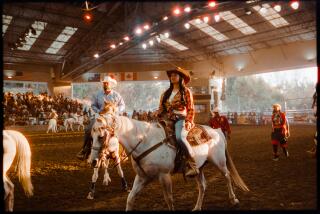A Big ‘T’ for Talent at Big ‘D’ Jamboree
- Share via
“The Big ‘D’ Jamboree--Live, Volumes 1 & 2,” a two-disc collection featuring live recordings by Johnny Cash and Carl Perkins, is a fascinating musical snapshot of the intersection between country music and rock ‘n’ roll in the 1950s.
Nashville’s Grand Ole Opry was the major leagues of country music, but its organizers--like most adults in the ‘50s--frowned on the upstart rock ‘n’ roll.
But there was another layer of country music showcases around the nation, one that was more tolerant of young rock performers because the owners saw that the music could lure new fans. Among these minor league operations: the Louisiana Hayride in Shreveport, La.; Town Hall Party in Compton; and the Big “D” Jamboree in Dallas.
Like the Opry itself, several of these “barn dances” were broadcast over radio and/or television, thus offering invaluable experience and exposure for such future Rock and Roll Hall of Fame members as Elvis Presley, Cash, Perkins and Jerry Lee Lewis.
Given rock’s rebellious image, it’s interesting to see how folksy and polite some of these rockers sound on the Big “D” Jamboree appearances. The shrieks in the background when Perkins sings “Blue Suede Shoes” indicate that lots of young rock fans were on hand, but the tone of the show is very traditional and adult.
Introducing “I Walk the Line,” for instance, Cash speaks to the crowd with the same kind of patter you’d expect from a country veteran such as Roy Acuff or Ernest Tubb.
“Thank you very much, friends,” Cash says during a show that was probably recorded in 1956. “It’s a real pleasure to be here with you all tonight at the Big ‘D.’ It’s always one of our biggest thrills to come to Dallas to play for all the wonderful folks down here . . . and here’s our latest on Sun [Records]. We hope you folks will enjoy hearing [it] maybe one more time.”
There’s a similar exchange when Perkins introduces his signature “Blue Suede Shoes” by calling it a song about “a pair of slippers.”
Disc 1--titled “Hillbillies”--features such name acts as Ferlin Husky, Hank Locklin, Cowboy Copas and Leon Payne, as well as such relative unknowns as Charline Arthur, who is described in the liner notes as “a talented country singer, tough and energetic, who not only responded to rockabilly, but in some ways anticipated it.” Her two tracks--including one written by Mae Axton, who also co-wrote “Heartbreak Hotel”--are intriguing enough to make a rockabilly enthusiast seek out the compilation of her music on the Bear Family label.
Disc 2--titled “Rockabillies”--offers a variety of cult and hit artists, including Gene Vincent, Warren Smith, Johnny Carroll and Jerry Reed.
Presley isn’t featured on the album, which was released by Dragon Street Records, but his presence was so dominant in rockabilly in the middle to late ‘50s, when these recordings were made, that it’s only fitting that three artists perform songs associated with him.
It’s also symbolic of the somewhat outcast nature of country music and rock at the time that the Big “D” Jamboree was held at the Sportatorium, a building mostly devoted to pro wrestling. In fact, the musicians performed on the same mat that the wrestlersused.
In the liner notes, album producer David Dennard describes how Ed McLemore, who ran the wrestling programs at the Sportatorium, saw the potential of country music in the area and became what Dennard describes as a mini-version of Presley’s manager, Col. Tom Parker. McLemore apparently became an important regional music force, “a mini-empire of management, publishing, booking, road shows and artist publicity concerns under his direction.”
But the rock ‘n’ roll sounds that initially helped draw new fans eventually ended up taking audiences away. “I think rock and roll just done us in,” Johnny Hicks, a DJ who was associated with the show, recalls in the album booklet. “After all, the generations were changing, the music tastes were changing. It was just one of those things that happened.”
While the Big “D” Jamboree lasted, however, it served as an important cultural bridge between country and rock. The music and recording quality are uneven on the two discs, but the spirit of the shows still comes through.
*
Robert Hilburn, The Times’ pop music critic, can be reached by e-mail at robert.hilburn@latimes.com.
More to Read
The biggest entertainment stories
Get our big stories about Hollywood, film, television, music, arts, culture and more right in your inbox as soon as they publish.
You may occasionally receive promotional content from the Los Angeles Times.










